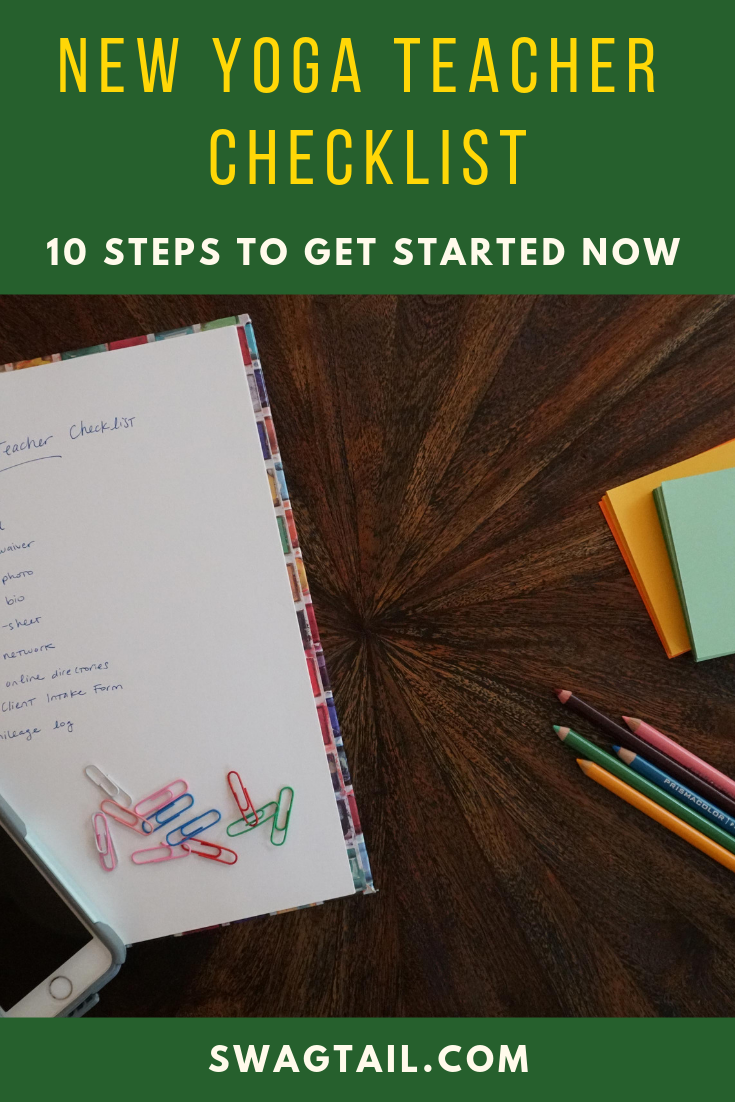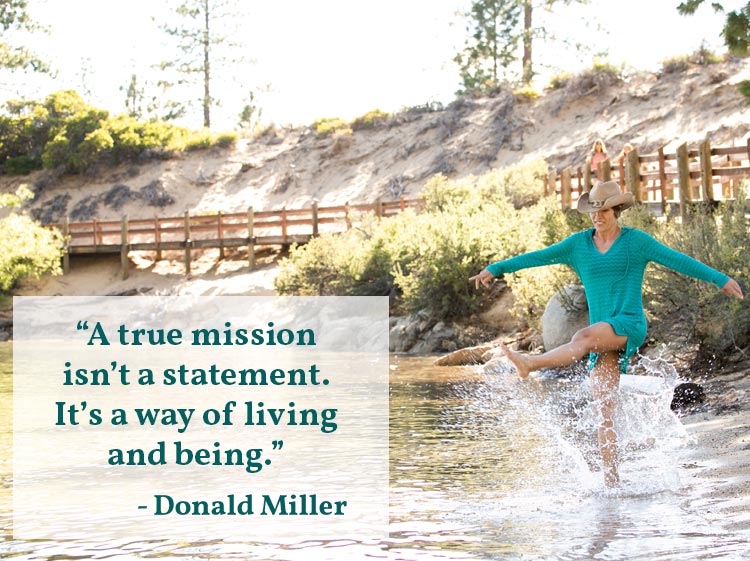 The numerous steps to take when starting a yoga business can seem overwhelming. Even new yoga teacher checklists provided online suggest building your brand from Day 1. While that can be important, this might add unnecessary pressure to do too much too fast. Instead, the 10-item checklist below will give you clarity about which simple steps to take first when you graduate. You can then confidently promote your new skills, knowing that you have the safety and logistical elements in place to do so.
The numerous steps to take when starting a yoga business can seem overwhelming. Even new yoga teacher checklists provided online suggest building your brand from Day 1. While that can be important, this might add unnecessary pressure to do too much too fast. Instead, the 10-item checklist below will give you clarity about which simple steps to take first when you graduate. You can then confidently promote your new skills, knowing that you have the safety and logistical elements in place to do so.
When I first started teaching yoga, I didn’t have much of a plan to market myself. Thankfully, I recently graduated from with my master’s degree and had a clear resume in place. Common sense also taught me that I needed to reach out to people I knew in the yoga industry for support. That’s actually how I found my first teaching position–through an existing contact. Then, over time, I also figured out other items necessary to grow my yoga business.
It’s been my experience over the past 15 years that much of your success comes from the preparation you do in advance of any action. These steps don’t have to be challenging, they just need to be placed on your radar and given a bit of attention. My goal for you is that you can use this checklist as a way to get your momentum moving forward in the yoga field. And, you’ll save time and energy down the road by doing so now.
(1) PURCHASE YOGA INSURANCE
You might think that yoga insurance pertains only to yoga studios or large corporations. However, given the fact that your students could potentially get hurt even when you’re working with them in a one-on-one situation, it’s essential that you purchase yoga insurance for yourself.
When you are purchasing a policy, make sure that it covers all forms of yoga that you plan to teach, including massage, body work, or any other products that clients might consume for their health benefit (such as Ayurvedic remedies). You’ll also want to check for elements that might be excluded from coverage. Many insurance companies do not want to cover aerial yoga, acro yoga, or even some herbal supplements.
Just make sure you contact the insurance companies directly with your questions before purchasing an insurance policy. That way you can pay for the best policy to suit your unique teaching skills.
Some Yoga Insurance Options
- Hands On Trade, $145 per year
- BeYogi Insurance Plus, $159 for part-time and $179 for full time
- Teachers Plus, $135 + a membership fee. Thus the sign-up cost is around $225.
- NACAMS (National Association of Complementary and Alternative Medicines), around $179
Please note that many of these companies also have discounted rates for students, part-time teaching, or even multiple-year policies. Also, the last two options mentioned above require lots of personal information before providing a quote.
(2) GET CPR CERTIFIED
CPR stands for Cardiopulmonary Resuscitation. If a person stops breathing, or their heart stops beating effectively, you can use CPR to restore oxygen-filled blood to vital organs. Most people who suffer from heart attacks or heart-related deaths are in their older years. Yet, you never know when something unexpected could occur during a yoga class.
You can get CPR certified online for $12.95 but I highly recommend that you take the time to find a class near you to attend in person. This interactive experience is usually only a few hours in length and you get hands-on attention. This is especially useful for your first round of certification. You’ll need to renew this every two years, so perhaps the cost-effective option would be good for a refresher.
(3) DEVELOP A CLIENT INTAKE FORM
If you teach at a studio or other location, they will likely provide a client intake form. But what if you want to teach friends, family, and private clients immediately? Then, we suggest you create a client intake form of your own.
Once you have a person interested in taking yoga with you, the intake process begins. Essentially, it’s a way for you to introduce clients to your yoga business, as well as get the information you need about them to make their yoga experience more successful.
Client intake forms usually collect information such as:
- Names (and nicknames)
- Address (physical and email)
- Phone
- Prior experience with yoga
- Yoga goals/reasons for practicing, or
- Any conditions you would need to know about (injuries, pregnancy, etc)
You can initially print client intake forms and bring them with you to your teaching locations. Students can then fill them out before the session begins. Once you have a website, you might consider a digital copy they can submit directly online. You could even get creative and use a Google form sent via email to do this prior to having a live website, too.
Many times, client intake forms are paired with the next yoga teacher checklist item. However, we suggest that they remain two separate documents in your filing system for each student. This can be beneficial should there be any legal issues down the road.

Photo Credit: Sebastian Voortman
(4) USE A LIABILITY WAIVER
Yoga is a mindful practice, and although it would be ideal to think no injury or lawsuit would occur, this simply is not the case. Thus, it’s essential to consider legal and financial protection. There is no way to eliminate risk of a lawsuit entirely, but you can use a liability waiver for your students as a good safeguard.
A liability waiver is considered an exculpatory contract which attempts to excuse or relieve you–as the yoga teacher–of responsibility for injuries to a participant that arise during physical activity. Some of these risks are known, and some are unknown. Since each country and state is slightly different, it’s best to have a well-drafted liability waiver drafted by a legal professional. Then, ensure it is signed by each student prior to their participation in yoga with you (whether they are paying to participate with you, or not).
(5) TAKE A HEADSHOT PHOTO
You’ve heard the phrase, “Put your best foot forward.” In the case of a headshot photo, you want to do so with your face! Essentially, the headshot is one of the first impressions you make with new students, so you want it to be done well.
If you’re on a budget, you can even get a friend to take your headshot photo-thanks to the high camera quality on many phones these days. Or you can hire a professional photographer for a mini session that could include a headshot and some yoga postures. Any extra images you get during that time can be great material to add to your website and social media channels down the road. In either case, just make sure you have great lighting and a background that doesn’t take away from your shining face!
(6) CRAFT A SHORT BIO
Your bio is a quick reference for people to get to know about you and your teaching style. While you might mention training and certifications to verify your credibility, you really want to talk about the transformation yoga has provided in your life. Better yet, talk about the transformations that are possible for your students. Many teachers fail to do this and miss the opportunity to really connect with potential students as a result.
Consider these questions when crafting your bio:
- What problem does yoga solve for you?
- How are you different now after practicing yoga?
- How do you create this possibility to transform for your students?
- In what ways do you invite students to take action with you?
- What unique interests and talents do you possess that contribute to your worldview?
- What credentials and trainings do you possess? How are they relevant to a student’s experience with you?

Photo Credit: Diane Nicole Photography
(7) CREATE A ONE SHEET
A one-sheet is like a modern-day resume that is designed to showcase your unique skills. Instead of listing all of your talents and interests, you can use a single sheet of paper to highlight what you want most when working with studios or other partners in town.
Think clear wording, succinct phrases, and a less-is-more mindset. In addition to your headshot, short bio, and contact information, here are some items to include on your one-sheet:
Your Goal
Do you want a teaching position? Do you want potential clients to know about new yoga opportunities with you? Would you like to partner with a colleague in town to teach classes at their facility? Once you know “why” you want to gain exposure, then you can invite others to be part of your future.
Your Impact
If you have any testimonials about working with others already, then case studies of their transformation can be a powerful way to sing your praises. Even if you have not yet taught yoga, ask friends and family to offer testimonials about your integrity, focus, and other great qualities. Just one or two honest pieces of feedback should suffice.
A Call to Action
Once someone reads your one-sheet, what do you want them to do? Call you to schedule an appointment? Reach out to you for an interview? Visit your website or sign up for a class? Consider what you want and need most when starting your yoga business and use this as a guideline for what to request from others.
(8) LEVERAGE YOUR EXISTING NETWORK
As a new teacher, it’s essential to share your new yoga venture with your existing network of friends, family, and colleagues. Your priority is to start teaching, and that can be in any capacity. You just want to get in front of people to practice your technical skills and apply your newly-acquired knowledge. Working with people directly is the best way to do that. Yet people can’t find you if they don’t know what you’re doing.
For example, I just chatting with some neighbors when out for a walk with my dog. One of them happens to own an art studio. During our conversation, I discovered that in their large warehouse space, they set up a room for yoga and meditation. In fact, they are looking for someone to teach in that space. My point is that you just never know where you’ll find opportunities to teach or find students. Amazing doors can open when you open your mouth, share about your yoga teaching, and reach out to your existing network for support.
(9) UTILIZE FREE ONLINE DIRECTORIES
Developing an online presence is one of the most important things to do as a yoga business. But you don’t have to build a website right away to do this. There are plenty of online directories that offer free listings about your services. Some of these examples include Yoga Alliance, Yoga Finder, Yoga Trail, and One Yoga Directory. You can also search specifically to your area, as certain countries and states might have their own directory that you also utilize at no cost.
A note of caution here. You will want to be aware of what personal information will be published by these directories. Instead of giving out your personal phone number, you might want to add a business line to your existing cellular plan. That number can then ring directly to your phone, but without your private digits being revealed to the masses.
Also, consider creating a business email address as well. This could be an alias in your existing GSuite account or a separate email in general. Don’t worry too much about branding at this point. You just want to have a safe, and separate, way to have people reach you for your yoga business.

Photo Credit: Makito Tateisi
(10) START A MILEAGE LOG
A mileage log is a great way to track how many miles you’re using in your yoga business. This is especially true if you’re an independent contractor, traveling to different locations to teach yoga. While this might not seem like a big deal right now, it can be beneficial to get in the habit of calculating miles driven now. This can lead to tax deductions down the road.
There are simple apps for your phone that can help with this process. These include MileIQ, TripLog, EverLance, or QuickBooks Tracker. If you don’t want big brother looking over your shoulder, then you can also purchase a manual log to place in your glove box. You can then mark trips made specifically for yoga by hand.
PUTTING IT TOGETHER
There are many business items to address when you become a new yoga teacher. Instead of feeling overwhelmed, start with small action items in this new yoga teacher checklist. Each step you take to be organized now will set you up for success down the road. And, you can spend more of your time and energy focusing on your teaching skills instead.
Take Action Now:
- Download the checklist above to stay well-organized as a new yoga teacher.
- Check out our 90-minute workshop about yoga business basics (which is if you want to be a part- or full-time teacher)
- Discover what it takes to teach yoga online like a pro
Join us next week as we discuss how to handle angry yoga clients. Then, on a separate subject, we’ll talk about the importance of high quality yoga photos to build your brand.








Leave A Comment